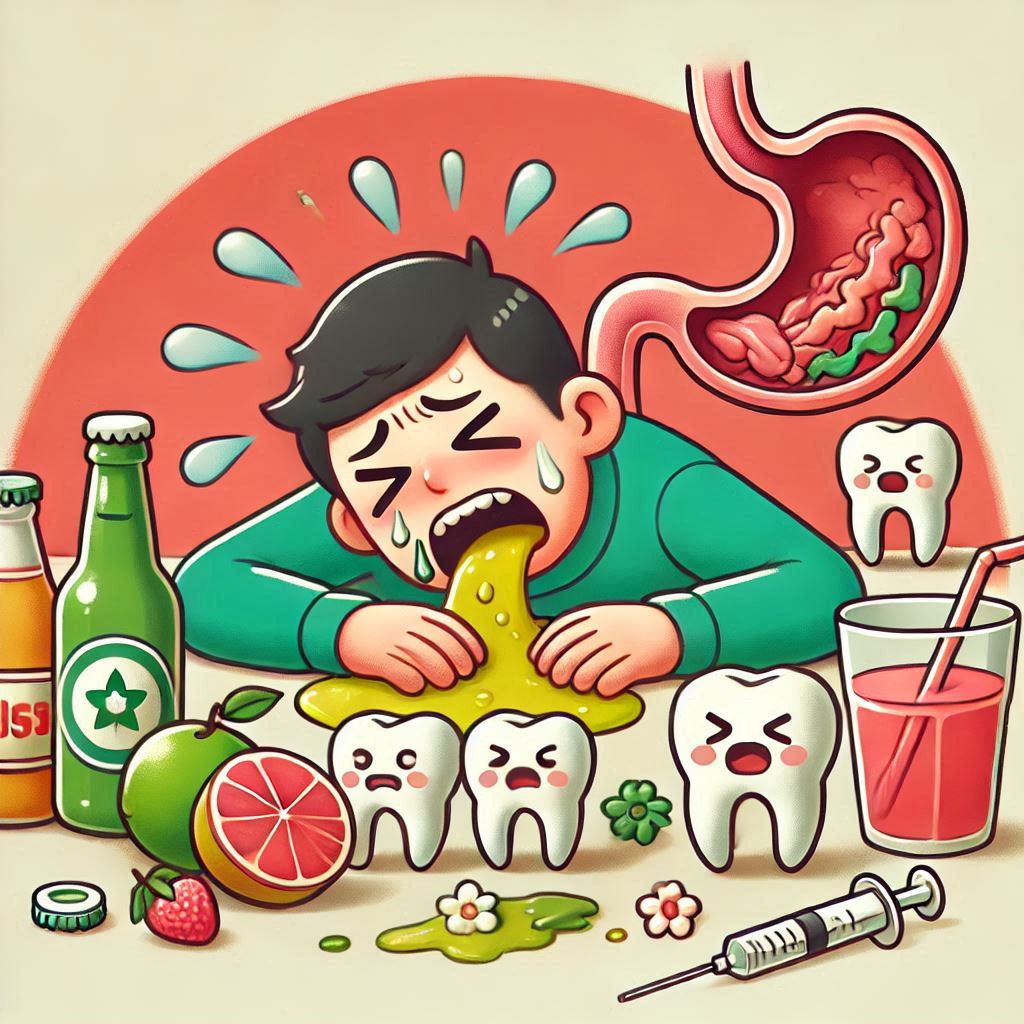Introduction and Understanding the Risks of Vomiting on Oral Health
Vomiting can occur for a variety of reasons — food poisoning, infections, pregnancy, or even stress-induced reactions. Regardless of the cause, one thing remains constant: vomiting can significantly impact your oral health if not properly managed. This damage is often more insidious than most people realize, as the effects of stomach acid on your teeth can go unnoticed until it’s too late.
The Impact of Stomach Acid on Your Teeth
Stomach acid, or gastric acid, is produced to help break down food and digest it. It is primarily composed of hydrochloric acid (HCl), which plays an essential role in the digestive process. In fact, stomach acid is potent enough to dissolve food particles and kill harmful bacteria that may enter the stomach. However, when this acid enters the mouth — as it does during vomiting — it can wreak havoc on your teeth.
When vomit enters the mouth, it introduces a concentrated amount of acid to the enamel, the outer layer of your teeth. The enamel is made of hydroxyapatite crystals and is the hardest substance in the human body. However, it is also vulnerable to erosion when exposed to acidic environments, especially over prolonged periods or with frequent exposure.
The enamel itself doesn’t regenerate naturally once eroded, making protection against acid damage even more critical. Without this protective layer, the underlying dentin becomes exposed, leading to heightened sensitivity and increased vulnerability to cavities. Over time, the repeated cycles of vomiting can result in significant tooth damage, leading to irreversible consequences.
How Stomach Acid Affects Tooth Enamel
The acid from the stomach is much stronger than the mild acidity found in everyday foods like citrus or vinegar. The pH level of gastric acid typically ranges between 1.5 and 3.5, which is very acidic. By comparison, the pH level of healthy enamel is about 5.5, and anything below that threshold can start to cause erosion. When stomach acid enters the mouth, it has the potential to lower the pH of the oral cavity, thereby softening and demineralizing the enamel.
The Process of Enamel Erosion
When stomach acid is introduced to the mouth during vomiting, it temporarily softens the enamel. This softening process makes the enamel more susceptible to mechanical wear, such as brushing or chewing. Here’s how the process unfolds:
- Acid Exposure: When vomiting occurs, gastric acid enters the mouth, lowering the pH in the oral cavity. This increased acidity starts to dissolve minerals in the enamel, leading to a phenomenon known as demineralization.
- Enamel Softening: The enamel softens when exposed to acid, making it easier for it to be worn down by even the act of brushing or eating.
- Loss of Minerals: Demineralization means that essential minerals like calcium and phosphate are leached out of the enamel. These minerals are critical to maintaining the strength and integrity of the enamel. Without them, the enamel becomes weaker.
- Surface Roughness: The breakdown of enamel can result in microscopic roughness on the tooth surface, making it more prone to staining and further degradation. This rough surface can also collect more plaque and bacteria, contributing to the risk of cavities.
- Long-Term Consequences: Over time, if the enamel continues to erode, the underlying dentin is exposed. Dentin is more porous and less durable than enamel, which increases sensitivity and leaves the tooth vulnerable to decay. Additionally, without enamel, teeth can become discolored, appear dull, and may lose their overall shape and structure.
Severity of Damage from Repeated Vomiting
The severity of the damage to your teeth will depend on several factors:
- Frequency of Vomiting: Individuals who vomit frequently, either due to medical conditions (like gastroesophageal reflux disease, or GERD), eating disorders, or regular alcohol consumption, are at a higher risk of enamel erosion.
- Amount of Stomach Acid: The more concentrated the stomach acid, the greater the potential for damage. For example, vomiting that brings up bile (from the small intestine) is even more damaging because bile is even more alkaline and aggressive.
- Oral Hygiene Habits: Those who brush their teeth aggressively or immediately after vomiting without giving the enamel time to re-harden are at a greater risk of causing additional damage to the enamel.
What to Do Immediately After Vomiting
Knowing how to respond to the effects of vomiting on your teeth is essential for minimizing the damage. Following the right steps immediately after vomiting can help protect your teeth from lasting harm.
Rinse with Water (Not Mouthwash)
The first thing you should do after vomiting is rinse your mouth with plain water. This helps wash away any remaining stomach acid and dilute the harmful substances in your mouth. If you don’t rinse your mouth, the acid will continue to sit on your teeth, increasing the risk of enamel erosion.
Wait Before Brushing Your Teeth
After vomiting, it’s tempting to immediately brush your teeth to get rid of the acidic taste and remnants of vomit. However, brushing too soon can cause further enamel damage. As mentioned earlier, the enamel softens after exposure to acid, and brushing can lead to unnecessary abrasion, compounding the damage. It’s important to wait for at least 30 minutes to an hour before brushing. This gives your saliva time to neutralize the acid and remineralize your enamel, making it safer to brush.
Use a Baking Soda Rinse
A good option for neutralizing acid and protecting your enamel is to use a baking soda solution. Baking soda is alkaline, and it can help balance the pH of your mouth after the acidic experience of vomiting. To do this, dissolve a teaspoon of baking soda in a glass of water and swish it around in your mouth for 30 seconds. This can further help neutralize stomach acids without harming your teeth.
Common Mistakes People Make After Vomiting
Many people inadvertently cause more harm to their teeth after vomiting because they don’t understand the risks involved. Here are some common mistakes to avoid:
- Brushing Immediately After Vomiting: As discussed earlier, brushing immediately after vomiting can cause additional enamel erosion. The acidic nature of stomach acid softens the enamel, and brushing at this time can accelerate wear and tear.
- Using Alcohol-Based Mouthwash: Alcohol-based mouthwashes can dry out your mouth and irritate any sensitive tissue in your mouth, increasing the discomfort after vomiting. Additionally, they may not be as effective in neutralizing stomach acid.
- Consuming Acidic Foods and Drinks: After vomiting, it’s common to want to soothe your stomach with acidic beverages like orange juice or lemon water. However, consuming these kinds of drinks after vomiting can further damage the softened enamel.
The Science of Tooth Enamel and Acid Erosion
Understanding the science behind enamel and acid erosion can help you take better care of your teeth, especially after vomiting. The enamel on your teeth is primarily composed of hydroxyapatite, a crystalline structure made of calcium and phosphate. When acids, like stomach acid, interact with this structure, the minerals are dissolved, leading to demineralization.
The Role of Saliva in Protecting Your Teeth
Saliva plays a vital role in neutralizing acids and re-mineralizing your teeth. After vomiting, your saliva production may decrease, which is why it’s crucial to hydrate and encourage saliva flow. Drinking water and chewing sugar-free gum can stimulate saliva production, which will help counteract the acid.
Preventive Measures for Ongoing Protection
When vomiting becomes a recurrent issue, whether due to a medical condition like gastroesophageal reflux disease (GERD), a pregnancy-related issue like morning sickness, or even stress and anxiety-induced vomiting, it’s important to develop a long-term strategy to protect your teeth. Here are some measures you can take to reduce the risk of acid erosion and protect your enamel over time.
Use a Neutralizing Mouthwash
One of the easiest ways to protect your teeth after vomiting is by using a neutralizing mouthwash. Standard mouthwashes often contain alcohol and may not help in neutralizing stomach acid effectively. Instead, look for fluoride-based or alkaline mouthwashes that help neutralize acidity in the mouth and promote remineralization of the enamel. Some of these products even contain calcium or phosphates to help fortify enamel, making them beneficial for anyone who experiences frequent vomiting.
Rinse with a Baking Soda Solution Regularly
Rinsing your mouth with a baking soda solution is another simple and effective way to help neutralize acids and prevent enamel erosion. Baking soda is mildly alkaline and will help to neutralize the acid, raising the pH balance of the mouth, and allowing the enamel to recover. To use, simply dissolve a teaspoon of baking soda in a glass of water and swish it around for 30 seconds. This should be done only a few times a day, especially after vomiting, to avoid overuse.
Use a Straw for Acidic Drinks
If you’re someone who often consumes acidic beverages — like citrus juices, soda, or coffee — using a straw can help reduce contact between the acidic liquid and your teeth. The straw directs the liquid to the back of your mouth, minimizing the potential for acid exposure to your enamel. For individuals prone to vomiting, this method can be particularly useful to avoid exacerbating acid-related tooth damage.
Limit Acidic Foods and Drinks
While it’s important to stay hydrated, you should be cautious of consuming foods and beverages that are highly acidic right after vomiting. Acidic items such as citrus fruits (oranges, lemons, limes), vinegar-based products, tomatoes, and carbonated sodas can further lower the pH in your mouth, increasing the risk of enamel erosion. It is essential to wait at least 30 minutes after vomiting before consuming such items, as your enamel will still be in a weakened state.
Chew Sugar-Free Gum
After vomiting, one of the best things you can do is chew sugar-free gum. Chewing gum promotes the production of saliva, which naturally helps to neutralize acids in the mouth and protect the enamel. Furthermore, gum with xylitol, a natural sweetener, can provide an added benefit as xylitol has been shown to help prevent tooth decay. Make sure to choose sugar-free gum because sugar can feed bacteria in the mouth, contributing to decay.
Long-Term Oral Health Strategies
Protecting your teeth after vomiting isn’t just about the immediate aftermath. Over time, if vomiting is a regular occurrence, you’ll need a more comprehensive approach to ensure your long-term dental health. Here are some strategies for maintaining good oral hygiene and minimizing the effects of stomach acid on your teeth.
Regular Dental Checkups
If you frequently experience vomiting, it’s important to see a dentist regularly for checkups and cleanings. Your dentist will be able to monitor the condition of your enamel, check for signs of erosion, and offer personalized advice on how to best protect your teeth. They may also provide fluoride treatments to help strengthen your enamel. The earlier enamel erosion is detected, the better the chance of mitigating long-term damage.
Fluoride Treatments
Fluoride is a mineral that strengthens tooth enamel and helps to reverse early stages of enamel demineralization. If you have a history of frequent vomiting or exposure to stomach acid, consider asking your dentist about fluoride treatments. These treatments are often applied in the office and can help remineralize weakened enamel. You can also use fluoride toothpaste or mouth rinses for daily protection.
Maintain a Consistent Oral Hygiene Routine
Maintaining a consistent oral hygiene routine is crucial to protect your teeth. Brush twice a day with a soft-bristled toothbrush and fluoride toothpaste, and floss daily to remove plaque from between your teeth. Plaque buildup can contribute to enamel erosion and cavities, so keeping your mouth clean is essential.
Hydrate and Balance Your Diet
Regular hydration is key to promoting healthy saliva production. Saliva is your mouth’s natural defense against acids, helping neutralize them and wash away food particles. Drink water regularly throughout the day, and try to avoid beverages that contain acid or sugar, as they can erode enamel. A well-balanced diet rich in vitamins and minerals, especially calcium and vitamin D, can also support your enamel and overall oral health.
When to Seek Professional Help
Sometimes, no matter how diligent you are with oral care, frequent vomiting can lead to permanent damage to your teeth. If you notice any of the following signs, it’s important to see your dentist or healthcare provider as soon as possible:
Tooth Sensitivity
Tooth sensitivity is one of the first signs of enamel erosion. If you find that your teeth are sensitive to hot, cold, or sweet foods and drinks, it may indicate that the enamel has worn down. Severe tooth sensitivity can also be a sign of exposed dentin, the layer beneath the enamel. Your dentist can assess the level of damage and recommend treatments to help reduce sensitivity and restore tooth health.
Visible Tooth Damage
If you notice that your teeth appear yellow, worn, or chipped, it could be a sign that the enamel has been eroded. Visible damage may require restorative treatments, such as dental bonding, veneers, or crowns, to repair the affected teeth. These procedures can help protect the underlying dentin and restore the appearance of your smile.
Recurring Gum Infections or Decay
Frequent vomiting can contribute to a higher risk of oral infections due to the increased acidity in the mouth. If you experience persistent gum inflammation, bleeding, or signs of decay, it’s important to seek professional help. A dentist can provide treatments like deep cleanings or prescribe antibiotics if necessary to address gum issues.
9Special Considerations for Children, Pregnant Individuals, and Other Vulnerable Groups
Certain groups of people are more susceptible to the effects of vomiting on their teeth. Here are some considerations for those in these categories:
Children and Adolescents
Children’s teeth are more susceptible to damage from stomach acid because their enamel is still developing. If your child vomits frequently due to illness or a medical condition, it’s crucial to take proactive steps to protect their teeth. Teaching them good oral hygiene habits, such as rinsing their mouth with water after vomiting, can help minimize damage. If the vomiting is frequent, consult with a pediatric dentist who may recommend fluoride treatments to strengthen their enamel.
Pregnant Women
Morning sickness, which affects many women in the early stages of pregnancy, can result in frequent vomiting. This places extra stress on the enamel and may lead to increased sensitivity and wear. Pregnant women should be especially careful to avoid brushing their teeth immediately after vomiting. Instead, rinsing with water or baking soda solutions is a safer alternative to protect the enamel. Additionally, a dentist may provide fluoride supplements to help prevent enamel erosion.
People with Eating Disorders
Individuals with eating disorders, particularly bulimia, are at an extremely high risk for tooth damage due to frequent vomiting. Bulimia can lead to severe enamel erosion and significant tooth decay. If you or someone you know is struggling with an eating disorder, it is essential to seek both dental and psychological help. A dentist will work with you to develop a treatment plan that can prevent further damage while also addressing the underlying eating disorder.
Conclusion and Final Tips for Protecting Your Teeth
In conclusion, vomiting may seem like a transient event, but its impact on your oral health can be lasting if not managed properly. The stomach acid introduced during vomiting can cause irreversible damage to your teeth if precautions aren’t taken. Immediate actions such as rinsing with water, waiting before brushing, and using fluoride mouthwashes can help mitigate damage.
For long-term protection, maintaining good oral hygiene, using fluoride treatments, and staying hydrated are key to minimizing the effects of acid exposure. It’s also important to seek regular dental checkups to monitor any potential enamel erosion and address issues early on. Above all, remember that the best defense against acid erosion is a proactive approach — protect your enamel, and your smile will thank you for it!
SOURCES
American Dental Association (ADA). (2019). The effects of acid erosion on oral health. Journal of the American Dental Association, 150(6), 467-474.
Buchanan, R. M. (2017). The impact of vomiting on tooth enamel: A clinical perspective. Oral Health Review, 33(1), 12-15.
Gordillo, D. F., & Waters, C. M. (2018). Gastroesophageal reflux disease (GERD) and its effects on dental enamel: A review of the literature. Journal of Clinical Dentistry, 32(4), 212-219.
Liu, Y., & Zhang, H. (2020). Saliva’s role in dental erosion and remineralization after acid exposure. International Journal of Dental Hygiene, 18(3), 187-194.
McNeill, C., & Denton, M. (2019). A clinical guide to managing dental erosion caused by acid reflux and vomiting. Dental Clinics of North America, 63(4), 615-629.
Moynihan, P. J., & Kelly, S. A. (2018). Preventing tooth erosion: Guidelines for oral health practitioners. British Dental Journal, 224(9), 715-723.
Pohl, M., & Kopta, K. (2017). The consequences of recurrent vomiting on oral health: A review of enamel erosion and sensitivity. Journal of Pediatric Dentistry, 39(2), 142-148.
Rosen, A. C., & Thompson, P. D. (2020). Enamel erosion from repeated vomiting: Understanding the risks and the protective strategies. International Journal of Pediatric Dentistry, 30(1), 33-39.
Smith, R. W., & Smith, S. P. (2016). Dental management of patients with bulimia nervosa: A clinical approach. British Journal of Oral and Maxillofacial Surgery, 54(4), 279-284.
Wright, J. A., & Duncan, C. H. (2015). Gastrointestinal disorders and their impact on oral health: A clinical perspective. Dental and Medical Review, 23(1), 105-110.
Yip, K. H., & Liu, R. X. (2021). Managing tooth erosion in patients with recurrent vomiting: A comprehensive guide. Journal of Clinical Oral Investigations, 25(4), 1329-1342.
HISTORY
Current Version
January 23, 2025
Written By:
SUMMIYAH MAHMOOD




